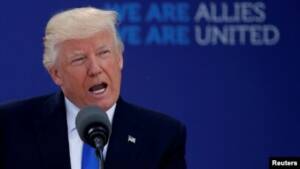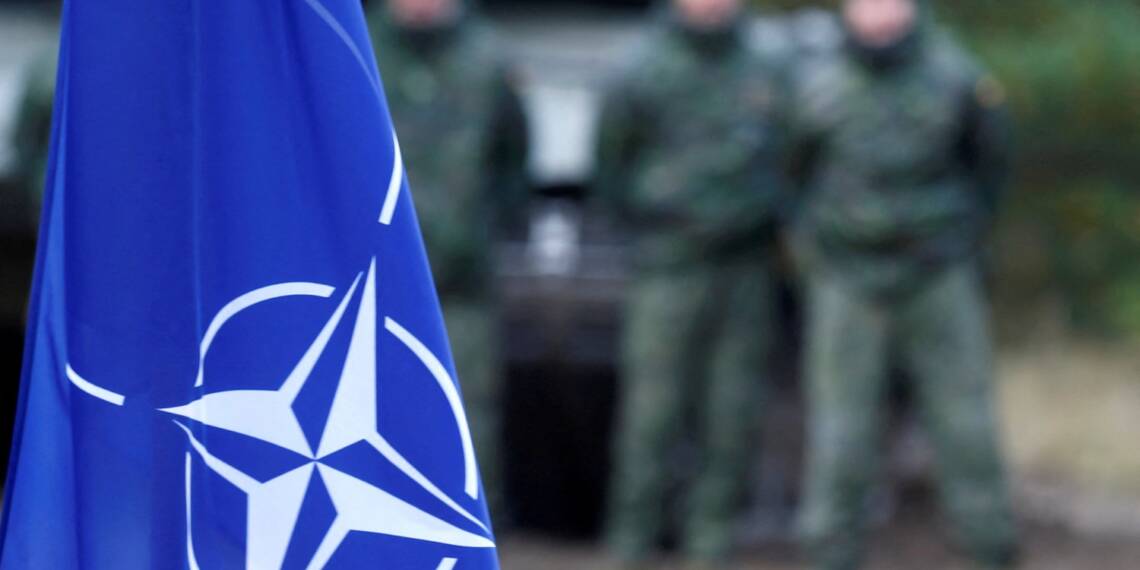In 2014, NATO members agreed to allocate 2% of their GDP to defense by 2025. By 2023, only a third of the alliance’s 30 countries had met this commitment, while 13 dedicated 1.5% or less of their GDP to defense, as per NATO’s data.
Donald Trump, speaking in South Carolina, argued that NATO countries failing to meet military spending targets should not expect US support in case of an attack. This stance was exemplified by Trump’s recounting of a dialogue with a NATO country’s leader, suggesting a refusal to defend allies not meeting spending goals, and even suggesting encouragement of adversarial actions against them.
Join us on Telegram: https://t.me/tfiglobal
NATO Secretary General Jens Stoltenberg responded to Trump’s comments with a warning that such statements threaten the alliance’s unity and security. Stoltenberg emphasized that undermining the principle of mutual defense endangers all member states, including the US, increasing risks for military personnel. He affirmed NATO’s readiness to defend all allies and expressed confidence that the US would continue to be a committed member of the alliance, regardless of election outcomes.
Before we analyze Trump’s actions on NATO, let’s jump into NATO history first:
NATO, the North Atlantic Treaty Organization, was established in 1949 by 12 founding members, including the United States, Canada, and several Western European countries. It was created in response to growing concerns about the Soviet Union’s expansionist policies post-World War II.

The foundation of NATO was built on the principle of collective defense, as outlined in Article 5 of the North Atlantic Treaty. This principle states that an attack against one member is considered an attack against all members, a commitment that has been the cornerstone of the alliance’s strategy to maintain security and peace among its members. Throughout its history, NATO has expanded to include 32 member states, incorporating countries from Central and Eastern Europe following the dissolution of the Soviet Union.
Read more: Trump’s Rule Sparks German Fears of NATO Collapse!
The dissolution of the Soviet Union in 1991 marked the end of the Cold War and, with it, the original rationale behind the establishment of the North Atlantic Treaty Organization (NATO) in 1949. NATO was primarily created to counter the Soviet Union’s expansionist policies and the spread of communism in Europe, providing a collective defense mechanism for Western democracies. With the Soviet threat no longer present, the question arises as to why NATO did not dissolve, considering its primary adversary had ceased to exist.
The emergence of Russia from the ashes of the Soviet Union presented a unique opportunity to redefine East-West relations. Russia in the early 1990s was neither communist as its predecessor nor imperialist in the tsarist sense. It was a moment that could have been seized to integrate Russia into a broader European security framework, fostering cooperation rather than confrontation. However, NATO not only continued to exist but also expanded eastward, incorporating former Warsaw Pact countries and Soviet republics into its fold. This was a missed opportunity to treat Russia as a potential partner.
The decision to maintain and expand NATO post-1991 can be understood through various lenses, not least the geopolitical and economic interests of its members, particularly the United States. Conflicts, or the preparation for them, have historically accelerated defense spending, benefiting the military-industrial complex through increased arms production and sales. Such expenditures have significant economic implications, including the creation of jobs and technological advancements. Moreover, military engagements and the presence in strategic regions have allowed NATO members to exert influence over key geopolitical areas, extending their reach beyond traditional spheres of influence.
Furthermore, military victories and interventions have often rallied public support around governments, strengthening their domestic standing. This “rally around the flag” phenomenon can bolster political leadership during times of conflict or perceived threats, providing a justification for continued or expanded military spending and operations.
NATO acted without a clear purpose after 1991. First off, the Gulf War between 1990-1991 can be seen as NATO’s first foray into the Middle East. Immediately after the Gulf War, NATO was involved in the Bosnia and Herzegovina conflict from 1992 to 1995. NATO’s intervention in Bosnia and Herzegovina took violence and genocide occurring during the Yugoslav Wars as a reason to jump into the region. The intervention aimed to turn the Baltics into a dominion of NATO under the disguise of UN resolutions and peace agreements. Then came NATO’s intervention in Kosovo, leading to Kosovo’s eventual declaration of independence, which remains a contentious issue till date.

Read more: Italy is DeNATOising G7
Following the 9/11 attacks, NATO invoked Article 5 for the first time, initiating Operation Enduring Freedom in Afghanistan. The mission aimed to dismantle al-Qaeda and remove the Taliban from power. It turned out to be a 20 Year long practical joke as the Taliban managed to come back to power leading to NATO’s humiliating withdrawal.
NATO’s intervention in Libya was authorized by the UN Security Council Resolution 1973, aiming to protect civilians during the Obama Administration created Arab Spring that saw a number of rebels standing against Muammar Gaddafi’s regime. While Gaddafi was removed from power, the aftermath saw Libya grappling with instability and the rise of various armed groups. NATO tried to repeat the Libya playbook in Syria But Bashar Al Assad turned out to be a tough nut to crack.
The 2003 invasion of Iraq was led by NATO members. The mission, justified by the alleged presence of weapons of mass destruction, turned out to be a bundle of lies. It has had long-lasting effects on Iraq’s stability and regional dynamics.

NATO is directly involved in the conflict in Ukraine though not as fighter but as economic funders and military suppliers. The war has led to a complete destruction of Ukraine and a lot of personal wealth for Ukranian president Volodymyr Zelensky.
Donald Trump has a valid point regarding the North Atlantic Treaty Organization (NATO) and its role in the 21st-century geopolitical landscape merits a thorough examination. His viewpoint is grounded in several assertions about NATO’s purpose, its economic impact, and Trump’s foreign policy priorities, which emphasize a more isolationist and inward-looking stance compared to his predecessors.
Firstly, NATO does not fit into a multipolar world. NATO’s continued expansion and military posture will only exacerbate tensions rather than contribute to global stability.
Read more: NATO Sparks World War III Fears with Shocking Move!
NATO’s operations and existence serve more to fulfill political and economic interests rather than genuine security needs. The alliance helps to perpetuate the military-industrial complex, supports certain political agendas, and maintains dependency relationships with newer member states.
Trump’s criticism of NATO also aligns with his broader foreign policy approach, which emphasizes “America First” principles, advocating for reduced American involvement in international conflicts and alliances perceived as costly or unfair. Trump’s presidency was noted for its skepticism towards traditional multilateral agreements and military engagements, underpinned by a belief that these commitments drain American resources and distract from domestic priorities, such as job creation.

Moreover, no new major wars were initiated during Trump’s tenure as president, which highlights his commitment to avoiding foreign entanglements.
Trump’s stance on NATO and his broader foreign policy approach is rooted in concerns about the alliance’s relevance in the current geopolitical context, its economic implications for the United States, and the desire for a foreign policy that prioritizes domestic welfare over international military commitments.
Donald Trump’s approach towards NATO can be analyzed as a strategic maneuver aimed at challenging the alliance’s financial commitments from its members, rather than outright advocating for the dissolution of NATO. Trump has emphasized the need for member countries to fulfill their defense spending obligations, specifically the target of allocating 2% of their Gross Domestic Product (GDP) to defense, as agreed upon in 2014. It is a calculated move, especially considering the economic context in which many European countries find themselves.
Read more: Kremlin Reacts to NATO’s ‘Military Schengen’ Proposal
The aftermath of the COVID-19 pandemic and the economic repercussions of the conflict in Ukraine have left several European nations facing significant financial strain, with most nearing recession. In this context, Trump’s insistence on meeting the 2% spending target is seen as a challenge that many NATO members will struggle to meet. This situation provides Trump with a potential pretext for advocating for the United States to reduce its involvement or withdraw from NATO, based on the argument that other members are not adequately sharing the financial burden of collective defense.
The implication of such a strategy is profound, given the pivotal role of the United States in NATO. The U.S. is not only the largest contributor to the alliance but also a principal military and strategic force within it. The withdrawal of the United States, or even a significant reduction in its support, could lead to the dissolution of NATO.
So Trump is as usual playing smart, forcing NATO members to pay or get out. So it will be interesting to see if President Trump’s first executive order in March 2025 will be – getting the hell out of NATO.








